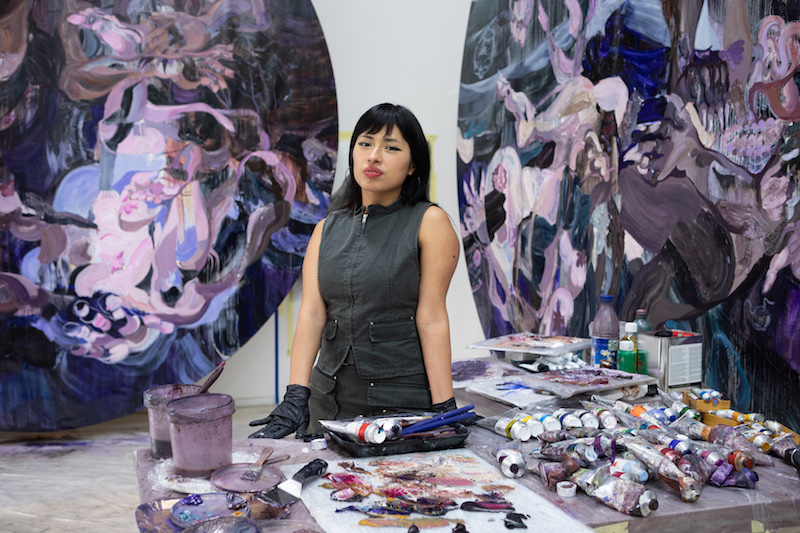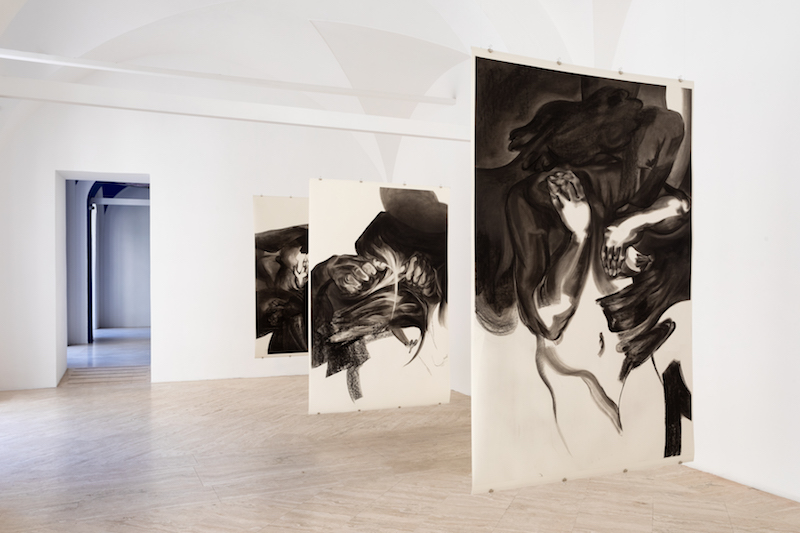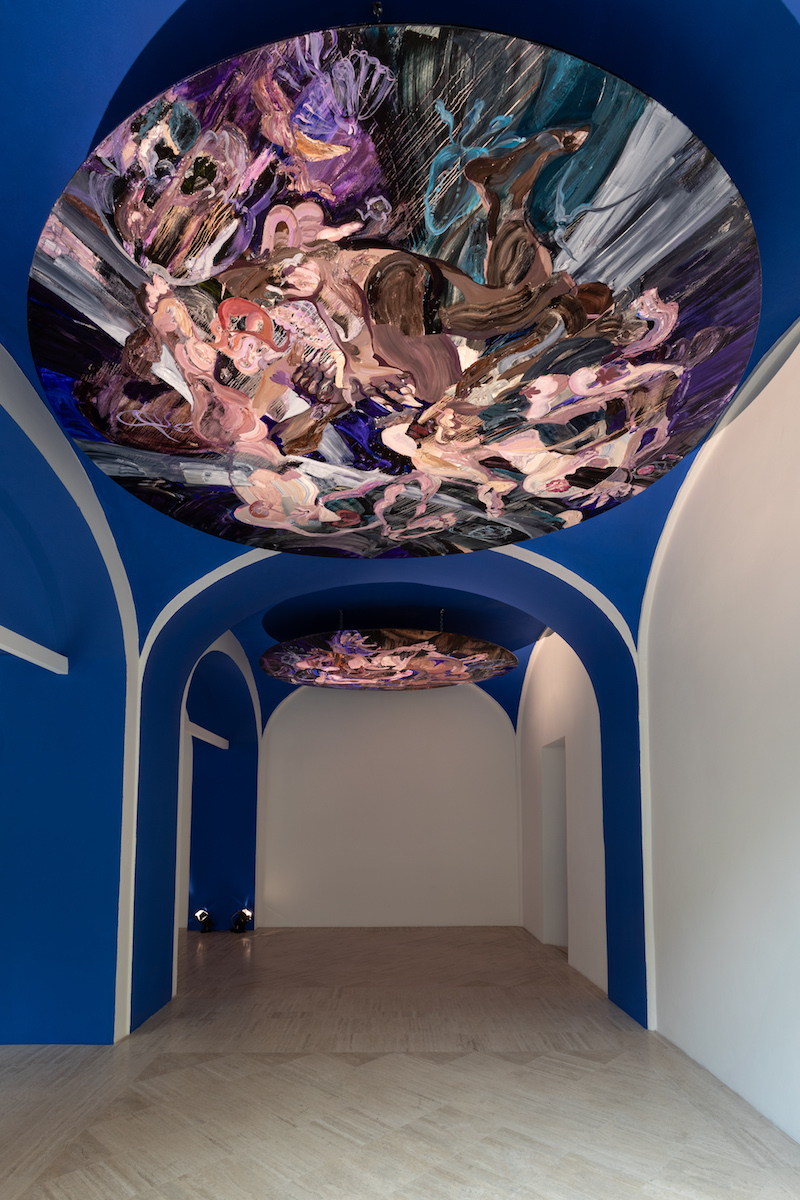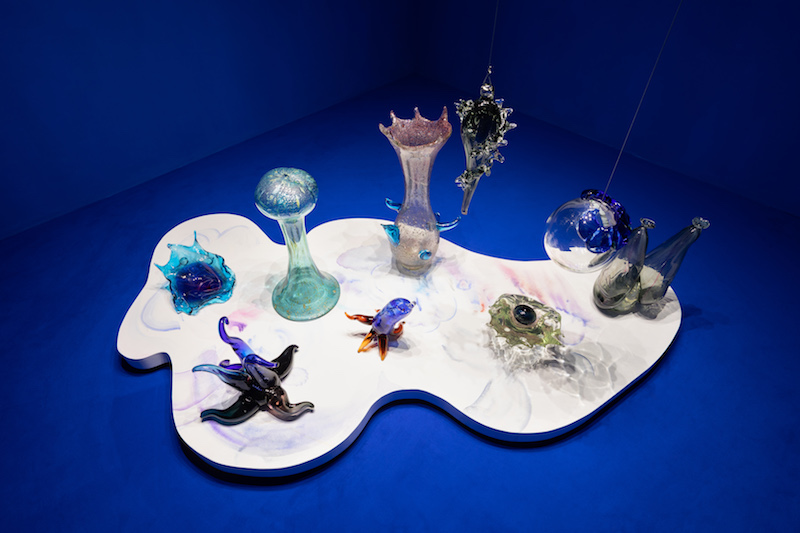by Nadia Egan // May 21, 2024
I recently read that Wynnie Mynerva had been described as one of the most fascinating artists of our time. In an era where few artists manage to create works that can still be disturbing, Mynerva reportedly stands out as one who can. It’s a bold claim, yet their provocative acts—such as sewing their vagina closed for an exhibition at Madrid’s Ginsberg Galeria in 2021 and surgically removing a rib for a show at New York’s New Museum last year—justify this reputation. I am intrigued by the grotesque and so, like a moth to a flame, I was eager to see what new daring deed would be displayed when I found out that the artist would open a show at the Fondazione Memmo in Rome. But, while the body remains central to the work in ‘Presagio,’ I was initially disappointed to learn that this show would be on the milder side.

Wynnie Mynerva, studio view at Fondazione Memmo, Rome // Photo by Daniele Molajoli, courtesy of the artist and Fondazione Memmo, Rome
Perhaps this is due to the theme of the work: the artist’s experience with chronic illness and how it has become an integral part of their life. Before learning more about the pieces, I had the preconception that they would, understandably, be quite heavy. I was surprised, however, to discover that this was not the case, as Mynerva’s practice offers a positive perspective on their relationship with their illness. Take, for example, the triptych of charcoal drawings in the gallery’s first room, titled ‘El Fantasma I-III’ (2024). At first glance, the large hanging works are dominated by a swirling, dark mass—a ghost (el fantasma) that invades and consumes the space. A human body is visible in the first drawing, but it gradually disappears, engulfed by the dark mass as one looks on towards the second and third drawings. However, what initially meets the eye is not the true intention behind the works. Instead of being invaded and consumed, the human body shown in the drawings is rather being embraced; a metaphor for how the artist deals with and accepts their illness.

Wynnie Mynerva: ‘Presagio [Omen],’ curated by Alessio Antoniolli, installation view at Fondazione Memmo // Photo by Daniele Molajoli, courtesy of the artist and Fondazione Memmo, Rome
Conceived during a residency at the gallery, the show is heavily influenced by and imbued with religious and art historical references from the city. This is particularly evident in the four oil paintings—’Casiopea,’ ‘Andromeda,’ ‘Hydra’ and ‘Berenice’—that adorn the ceiling of the gallery’s second room. I am immediately struck by the grandeur of these paintings, each measuring an impressive 330-by-340cm. To fully appreciate them, I have to crane my neck, an act reminiscent of gazing up at the ceilings of Roman churches, which number no less than 900 and often feature stunning ceiling paintings.
The artist also incorporates the ancient Greco-Roman astrological concept of melothesia, which assigns human body parts to celestial objects. This concept ties back to the artist’s illness, as practitioners of melothesia looked to the constellations as a means of understanding and healing the body, viewing it as part of a larger cosmic order. In these celestial compositions, various bodily systems are depicted: the nervous, cardiovascular, digestive, reproductive and immune systems, among others. Organs, limbs and bones emerge and dissolve within the flesh-toned paint, gradually revealing an entire body over time. It’s a beautiful and touching concept, to view the body, especially the sick body, as being one with the stars, living and working in symbiosis with the universe.

Wynnie Mynerva: ‘Presagio [Omen],’ curated by Alessio Antoniolli, installation view at Fondazione Memmo // Photo by Daniele Molajoli, courtesy of the artist and Fondazione Memmo, Rome
Tucked away in what can aptly be described as a grotto is a collection of colorful glass sculptures titled ‘Tesoros.’ Mynerva collaborated with a master glassblower in Venice for a single day to create these works, each impressively formed without a mold, using only the breath. The artist’s choice to use breath in the creation process draws again on religious iconography, evoking the idea of breathing life into something, like the divine act of God breathing life into humans. To me, the sculptures resemble sea creatures, an effect enhanced by the water-like rippling reflections beneath them and the deep Yves Klein blue that envelops the room. Despite finding them lovely, I struggled to find the connection between the works and the theme of the artist’s illness, something which had shown itself so clearly in the other two rooms.

Wynnie Mynerva: ‘Presagio [Omen],’ curated by Alessio Antoniolli, installation view at Fondazione Memmo // Photo by Daniele Molajoli, courtesy of the artist and Fondazione Memmo, Rome
As much as I was impressed by Mynerva’s exhibition—especially considering it was the first time they had worked with certain materials—the accompanying text’s promise of an “immersive environment” left something to be desired. While I was engaged on a visual level, I did not feel fully immersed in the show’s narrative. Despite the dissatisfaction brought on by my initial expectations, however, the merits of ‘Presagio’ should not be diminished. Mynerva offered a revitalized and intimately personal perspective on chronic illness. Instead of provocation, there was a sense of reconciliation between the artist and their lived reality, creating an environment in which to re-evaluate common perceptions about life with illness.
Exhibition Info
Fondazione Memmo
Wynnie Mynerva: ‘Presagio’
Exhibition: May 8-Nov. 3, 2024
fondazionememmo.it
Via della Fontanella di Borghese, 56/b, 00186 Rome, Italy, click here for map



















